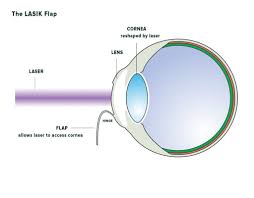Table of Contents
ToggleLASIK can temporarily disrupt the tear film, leading to dryness and changes in tear production. These effects vary for each patient and are often manageable with proper care.
The tear film is essential for maintaining healthy eyes and clear vision. It acts as a protective barrier, nourishes the eye surface, and provides effective lubrication. But what happens to this crucial protective layer after LASIK surgery? To fully understand this, let’s explore how LASIK interacts with the tear film, what impacts it may have, and how to manage them effectively.

Understanding the Tear Film and Its Role
The tear film is more than just “tears.” It consists of three critical layers, each serving distinct purposes for eye health and vision clarity:
- Lipid Layer (outermost): Prevents tear evaporation by forming a hydrophobic barrier on the tear surface. It helps stabilise the tear film.
- Aqueous Layer (middle): Makes up the majority of the tear film, providing nutrients, oxygen, and hydration to the cornea.
- Mucin Layer (innermost): Assists tears in spreading evenly across the cornea, ensuring the tear film sticks to the eye surface.
Healthy tear films are vital for optimal vision. Even minor disruptions to this delicate balance may lead to dryness or other ocular surface issues.
LASIK Procedure and its Interaction with the Tear Film
To understand how LASIK impacts the tear film, we need to take a closer look at the surgery itself. LASIK reshapes the cornea with the help of an excimer laser, correcting vision problems such as myopia, hyperopia, or astigmatism. However, this reshaping involves creating a corneal flap, which can influence the eye’s natural structure and, therefore, the tear film.
1. Disruption in Corneal Nerves
Key impact: LASIK severs some of the corneal nerves during the creation of the flap. These nerves are critical for signalling the need for tear production.
- Temporary nerve damage leads to reduced corneal sensitivity, which results in less stimulation of tear production.
- This reduction in tear generation may cause the eyes to feel dry after surgery.
Note: The nerves typically regenerate over time, which is why post-LASIK dryness symptoms usually subside within six months to a year.
2. Changes in Tear Film Distribution
The cornea’s altered curvature after LASIK can disrupt how tears are distributed across the eye surface. This often impacts the even spread of the tear film, leading to areas of dryness or irritation.
3. Tear Evaporation and Stability Issues
The altered tear film post-surgery may lack the same stability as before the procedure. Changes to the lipid layer can cause quicker tear evaporation, aggravating dryness symptoms.
Symptoms of Tear Film Disruption After LASIK
While LASIK has a positive impact on correcting vision issues, many patients experience symptoms linked to tear film disruption, such as:
- Dryness: The most common symptom, ranging in severity from mild discomfort to significant dryness.
- Burning or Grittiness: A sensation of something “in the eye.”
- Blurred Vision: Caused by an uneven or unstable tear film.
- Eyestrain: Discomfort after prolonged screen time or reading.
- Light Sensitivity: Mild photophobia as the cornea heals.
Post-LASIK dryness is a normal part of the healing process for many patients. However, persistent or severe symptoms should be discussed with an eye care professional.
Factors That Influence Tear Film Changes in LASIK Patients
Not all LASIK patients experience tear film disruptions in the same way. Several factors determine the extent and duration of these effects:
- Pre-existing Dry Eye: Patients with dry eye syndrome before LASIK are more likely to experience prolonged dryness post-surgery.
- Age: Older patients may be at a higher risk due to naturally declining tear production.
- Flap versus Flapless Techniques: LASIK involves creating a flap, which impacts the corneal nerves and tear film. Alternatives like SMILE (Small Incision Lenticule Extraction) tend to affect tear film less significantly.
- Corneal Thickness: Thinner corneas may experience greater postoperative sensitivity and dryness.
- Hormonal Factors: Women, particularly post-menopausal women, may experience heightened dryness due to hormonal changes.
Managing Tear Film Disruption After LASIK
The temporary effects of LASIK on the tear film can be effectively managed to ensure patient comfort and seamless recovery. Here’s how:
1. Use of Artificial Tears
Non-prescription artificial tears are one of the simplest and most effective methods for managing post-LASIK dryness. They help restore moisture and maintain tear film stability. Select preservative-free options to avoid irritation with prolonged use.
2. Prescription Eye Drops
For persistent dryness, ophthalmologists may prescribe:
- Anti-inflammatory drops like cyclosporine to reduce inflammation and improve tear production.
- Steroid eye drops during the initial healing phase to ease postoperative irritation.
3. Eye Protection Strategies
Protecting the eyes from environmental irritants can reduce tear evaporation:
- Wear sunglasses outdoors to shield from wind and dust.
- Use a humidifier indoors, especially in dry climates or air-conditioned spaces.
4. Punctal Plugs
For patients experiencing significant dryness, punctal plugs may be inserted to block the tear drainage system temporarily or permanently. This helps keep tears on the eye surface longer.
5. Omega-3 Supplements
Studies suggest that omega-3 fatty acids can improve tear production and reduce inflammation, enhancing overall tear film quality. Always consult your doctor before introducing supplements to your routine.
6. Follow-Up Appointments
Close monitoring during follow-ups allows for timely adjustments in post-surgical care. The ophthalmology team can provide customised recommendations to optimise tear film recovery.
Long-Term Effects of LASIK on the Tear Film
While most LASIK-related dryness and tear film instability are resolved within six months to a year, some patients may experience prolonged changes in tear film quality. This is more likely in individuals with pre-existing dryness or other risk factors mentioned earlier.
Preventive Measures for Affected Patients
To minimise long-term dryness:
- Undergo thorough dry eye evaluations before LASIK surgery.
- Discuss alternative procedures like SMILE if you’re at higher risk of severe dryness.
- Maintain a proactive approach to eye care, focusing on hydration and tear film protection.
Final Thoughts
LASIK may cause temporary disruptions to the tear film, most commonly resulting in dry eye symptoms. While these effects can be uncomfortable, they are usually manageable and improve over time as the eye heals. With proper pre-surgical evaluation, post-surgical care, and effective management techniques, LASIK patients can significantly reduce the effects on their tear film and enjoy the long-term vision benefits of the procedure.
Consulting an experienced ophthalmologist before surgery is crucial to addressing any concerns and creating a tailored plan for your unique needs. If you’re considering LASIK, schedule a consultation to assess your tear film health and determine the best approach for your vision correction.













